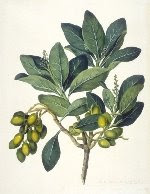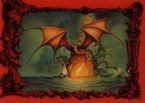SAMOAN MYTH
THE CREATION OF EARTH
There once lived a couple named Lu-tane and Lu-fafine (Lu-tane, the man and Lu-fafine, the woman). They lived for many years with their two beautiful daughters named Aloaloalela and Sautia. They lived for many years and they had as their matai or guardian, the sun. One day, the sun demanded Lu-tane and Lu-fafine to let their daughter Aloaloalela to marry him. The couple agreed even though they loved her, as they were scared of their matai. “Our dear daughter, Aloaloalela, the sun wants to marry you and take you as his wife.” said the parents. “He also informs us to let you know that he needs you tomorrow morning.”
The girl began to cry because she refused to marry him. However, she was frightened of the sun; she left early in the morning the next day to live with him. Days had gone and the old couple died. The other daughter, Sautia, moved over to stay with her sister and husband.
Sometimes later on, Aloaloalela became pregnant, and when she notified her sister about it, they planned to escape from the sun. So, they ran away, jumped into the sea, and continued swimming for a long time. “Alas, my leg has been bitten off by a shark.” cried out the other sister, Sautia.
Aloaloalela kept encouraging her sister to swim on and be strong; they would soon find a shallow
 area of the water to rest.
area of the water to rest.So, they kept swimming and later on, Aloaloalela yelled out, “Alas, I am about to give birth to a child”
“But there is nowhere when such an event can properly take place” responded Sautia. However, Aloaloalela then gave birth to nothing but just a clotted blood, which they ignored and continued to swim on.
Tagaloalagi, a god who lived in heaven as the Samoans believed, spotted this clotted blood from above and sent down his two servants to get it. They did as they were ordered and they brought it up to Tagaloalagi. He then took care of this lifeless mass and eventually transformed into a human being who later became a very handsome boy. Additionally, Tagaloalagi treated this boy as his own son.
The god, Tagaloalagi, witnessed from above the two sisters tiredly swimming for their lives in the wild roaring waves of the ocean.
He felt for these women that he used his godly power and rescued them by creating a small piece of land in the vast open sea. Aloaloalela and her sister Sautia who escaped from the sun continued to swim on and ultimately came across a shallow place in the ocean, where they were able to stop and rest for the first time since their swimming journey. As a matter of fact, it was only a small block of land suffice for the two women to set foot on, but it eventually grew slowly and slowly, larger and larger until it became a huge island.
It is the Samoan belief that this piece of land was the first land in the world, which is known as Manu’a, and later became the island of the two ladies, Aloaloalela and Sautia, who first occupied it.
Remember the boy who was saved, raised and cared for by Tagaloalagi; he was still under his care and his supervision, and he was then grew to manhood. Tagaloalagi had lived in the lagi tuaiva (ninth heaven) with his aiga (family) and there were lots of children in the family. However, this young man grew up as a strong boy, stronger than those kids and he could hit them anytime he wanted to.
Tagaloalagi’s sister was strongly disagreed with this kind of attitude, as it was unacceptable and objectable in the ninth heaven. One day, her children were beaten up again by the boy, they began to cry so loud that Tagaloalagi’s sister heard them and came to see what the problem was. She saw him kept thrashing her kids, which made her so enraged and furious.
The woman then jumped at the boy and began thrashing him exclaiming that, he was not a real son of Tagaloalagi and that he was cruel. Because of his disagreement and his unbelievable feeling of what the woman said, he started to cry and went to see Tagaloalagi.
“What’s the matter my son?” asked Tagaloalagi, “Why are you weeping?”
“Your sister told me I am not your true son. Would you mind telling me the truth?” the boy asked enthusiastically.
Tagaloalagi then admitted that he was not his real father and asked him
 to listen carefully whilst he explained everything.
to listen carefully whilst he explained everything.“Your mother married the Sun.” Tagaloalagi started informing him. “She later became pregnant and ran away with her sister. Aloaloalela, who is your mother, gave birth to you whilst swimming in the ocean. Therefore, I sent my servants to bring you up here because she left you floating behind. Now, I saved your life and took care of you for a long time. Nevertheless, I promise you I will release you to see your mother and her sister, but remember I want you to come back again.”
“Oh! thank you father. That’s great news for me. So, where are they?” asked the boy.
Tagaloalagi told him to look down the ocean and he would see them.
“Alas! My poor mother and sister.” cried out the boy. “They are being buried by the sun and drenched by the rain. Father, can you take me down to them?”
Tagaloalagi commanded his servants to take the boy to his mother.
They did so, and the women were startled to see him.
“Where do you two come from?” the boy asked.
“We ran away from the sun, who was our matai (guardian).” answered the women.
“Who is Aloaloalela?” he asked again.
“I am.” one woman replied while raising her hand. “This is my sister, Sautia.”
“Well, I have found out that you, Aloaloalela, has married the sun, and then you became pregnant and ran away from him. If I am right, where is your baby?” again asked the boy.
I had given birth to my baby whilst swimming and left him floating on the surface of this huge ocean, as I couldn’t do anything about it.
The two women then discovered some tears in the boy’s eyes which let them to confusion and hesitation.
A minute later, he started explaining his story.
“Mother, I am your baby. I am your son. I was found floating on the surface of the sea by the god of our universe, Tagaloalagi. He sent his servants to pick me up and carried me over to his kingdom (the ninth heaven). I was brought to life by him a
 nd took care of me till now.”
nd took care of me till now.”The boy could easily observe the shivering and the shaking of his mother’s body. However, he encouraged her not to worry about what happened because he had understood all the circumstances and the difficulties of what happened to her and her sister.
Afterwards, the mother hugged her son and asked for forgiveness. Nevertheless, the boy explained them that he would not stay with them, as he would return to the god, Tagaloalagi.
When the boy returned, he urged his father, Tagaloalagi to make the island of his mother and sister more beautiful, as there was only earth, but no shelter for them from the heat of the sun, Aloaloalela’s husband. Tagaloalagi then promised his son that he would do everything to protect his mother and sister from that cruel sun.
It was only Tagaloalagi’s words “Let there be trees of every kind, let there be animals and birds, and everything was there, making the women’s island so called Manu’a very beautiful and attractive.
The Samoan believed that this was the first piece of land in the whole world and it was called earth.






















